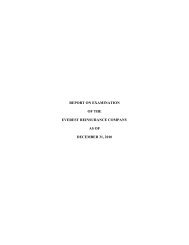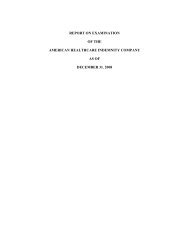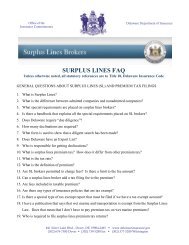Filing at a Glance General Information - Delaware Insurance ...
Filing at a Glance General Information - Delaware Insurance ...
Filing at a Glance General Information - Delaware Insurance ...
Create successful ePaper yourself
Turn your PDF publications into a flip-book with our unique Google optimized e-Paper software.
period to derive the provision included in the r<strong>at</strong>e level indic<strong>at</strong>ions.<br />
Attachment II<br />
Page 7<br />
The expense provisions for other acquisition and general expenses are shown in Exhibits 11 and<br />
12, respectively.<br />
Trend (Infl<strong>at</strong>ion)<br />
The method used to calcul<strong>at</strong>e the fixed expense trend is similar to the method used by the<br />
<strong>Insurance</strong> Services Office (I.S.O.) and other competitors to determine a fixed expense trend. The<br />
method utilizes the CPI (Consumer Price Index) and the ECI (Employment Cost Index –<br />
<strong>Insurance</strong> Carriers, Agents, Brokers, & Service) and is discussed by Geoffrey Todd Werner,<br />
FCAS, MAAA in his paper Incorpor<strong>at</strong>ion of Fixed Expenses, which was published in the CAS<br />
Forum (Winter 2004). Based on a review of the historical indices, an annual percentage change<br />
is selected for each index. These selected annual percent changes are then weighted together<br />
using the distribution of the Allst<strong>at</strong>e expenditures in the l<strong>at</strong>est calendar year for the two broad<br />
expense c<strong>at</strong>egories th<strong>at</strong> these indices represent. This method is expected to produce stable and<br />
reasonable estim<strong>at</strong>es of the true trend in fixed expenses and is consistent with the Current<br />
Practices and Altern<strong>at</strong>ives detailed in Appendix 1 – Background and Current Practices of<br />
Actuarial Standard of Practice No. 13, Trending Procedures in Property/Casualty <strong>Insurance</strong><br />
R<strong>at</strong>emaking. This trend is applied to all fixed expenses. Exhibit 13 shows the deriv<strong>at</strong>ion of the<br />
Factor to Adjust for Subsequent Change in Fixed Expense.<br />
Commission and Brokerage Expense<br />
Variable Expenses<br />
The proposed commission and brokerage expense provision has been developed from the most<br />
recent calendar year commission and brokerage incurred expense r<strong>at</strong>io in <strong>Delaware</strong>. The<br />
provision is shown on Exhibit 10.<br />
Taxes<br />
The provision for taxes is determined by taking the currently prescribed <strong>Delaware</strong> premium tax<br />
r<strong>at</strong>io and adding to th<strong>at</strong> the arithmetic average r<strong>at</strong>io of other assessments th<strong>at</strong> vary by the size of<br />
the premium from the l<strong>at</strong>est three calendar years in <strong>Delaware</strong>.<br />
Underwriting Profit Provision<br />
Allst<strong>at</strong>e performs two separ<strong>at</strong>e cost of capital analyses in the estim<strong>at</strong>ion of its cost of equity. The<br />
first uses the Fama-French Three-factor Model (FF3F), which reflects developments in the field<br />
of financial economics as published in the Casualty Actuarial Society Forum, Winter, 2004 and<br />
in Journal of Risk and <strong>Insurance</strong>, Vol. 72, No. 3, September 2005 (“Estim<strong>at</strong>ing the Cost of<br />
Equity Capital For Property-Liability Insurers” by J. David Cummins and Richard D. Phillips).<br />
The second is a Discounted Cash Flow (DCF) analysis, which estim<strong>at</strong>es the expected future cash<br />
flows to investors in order to gauge the proper cost of equity. Once both the DCF and FF3F<br />
estim<strong>at</strong>es had been calcul<strong>at</strong>ed, Allst<strong>at</strong>e selected a cost of equity of 10.00%, which reflected the






